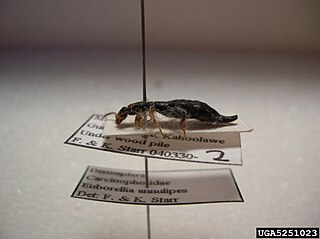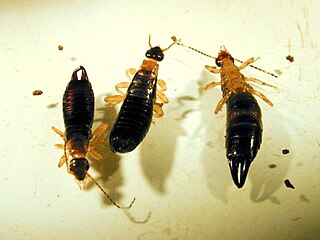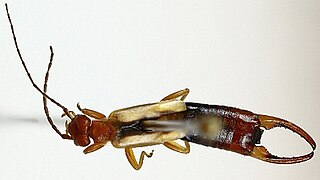
Earwigs make up the insect order Dermaptera. With about 2,000 species in 12 families, they are one of the smaller insect orders. Earwigs have characteristic cerci, a pair of forceps-like pincers on their abdomen, and membranous wings folded underneath short, rarely used forewings, hence the scientific order name, "skin wings". Some groups are tiny parasites on mammals and lack the typical pincers. Earwigs are found on all continents except Antarctica.

Pygidicranidae is a family of earwigs in the suborder Neodermaptera. The family currently contains twelve subfamilies and twenty six genera. Eight of the subfamilies are monotypic, each containing a single genus. Of the subfamilies, both Astreptolabidinae and Burmapygiinae are extinct and known solely from fossils found in Burmese amber. Similarly Archaeosoma, Gallinympha, and Geosoma, which have not been placed into any of the subfamilies, are also known only from fossils. Living members of the family are found in Australia, South Africa, North America, and Asia. The monotypic genus Anataelia, described by Ignacio Bolivar in 1899, is found only on the Canary Islands. As with all members of Neodermaptera, pygidicranids do not have any ocelli. The typical pygidicranid bodyplan includes a small, flattened-looking body, which has a dense covering of bristly hairs (setae). The pair of cerci at the end of the abdomen are symmetrical in structure. The head is broad, with the fourth, fifth and sixth antenna segments (antennomeres) that are not transverse. In general Pygidicranids also have equally sized ventral cervical sclerites, and in having the rearmost sclerite separated from, or only touching the center of the prosternum. Cannibalism of young has been observed in at least one species in the family, Challia hongkongensis, in which an adult female was found eating a still-living nymph of the same species. The same species in a different area has been observed possibly eating fruits or seeds, making the species an omnivore.

Forficulidae is a family of earwigs in the order Dermaptera. There are more than 70 genera and 490 described species in Forficulidae.

Forficula lucasi is a species of earwig found in Africa and has been introduced to Greece.

Arixeniidae is a family of earwigs in the suborder Neodermaptera. Arixeniidae was formerly considered a suborder, Arixeniina, but was reduced in rank to family and included in the new suborder Neodermaptera.

Hemimeridae is a family of earwigs in the suborder Neodermaptera. Hemimeridae was formerly considered a suborder, Hemimerina, but was reduced in rank to family and included in the new suborder Neodermaptera.
Microdiplatys campodeiformis is an extinct species of earwig in the family Protodiplatyidae. It is one of only two species in the genus Microdiplatys, the other being Microdiplatys oculatus.
Turanovia incompleta is an extinct species of archidermapteran earwig. It is the only species in the genus Turanovia and family Turanoviidae. It is found in the Middle-Late Jurassic (Callovian-Oxfordian) Karabastau Formation of Kazakhstan.

Anisolabididae is a family of earwigs, in the suborder Neodermaptera and the order Dermaptera.

Anisolabidinae, alternatively known as Carcinophorinae, Gonolabiinae, or Placolabidinae, is a subfamily of earwigs containing 17 genera.

Euborellia is a genus of earwigs in the subfamily Anisolabidinae. This genus, which has a world-wide distribution, was erected by Malcolm Burr in 1909 and was cited by Srivastava in Part 2 of Fauna of India.
Apachyidae is a small family of earwigs, in the suborder Neodermaptera and the order Dermaptera. It contains two genera.

Diplatyidae is a family of earwigs in the suborder Neodermaptera. It contains three subfamilies, and four genera incertae sedis, one modern and three extinct known from fossils.
Karschiellidae is the sole family of earwigs in the superfamily Karschielloidea. Like the family Diplatyidae, Karschiellidae is a relatively small family with few members.

Labiduridae, whose members are known commonly as striped earwigs, is a relatively large family of earwigs in the suborder Neodermaptera.

Labiinae, whose members are commonly known as little earwigs, is a moderately sized subfamily of earwigs in the family Spongiphoridae. It is a cosmopolitan family, whose members are small, winged earwigs, generally less than 1.5 centimetres (0.59 in) in length.

Neodermaptera, sometimes called Catadermaptera, is a suborder of earwigs in the order Dermaptera. There are more than 2,000 described species in Neodermaptera.

Anechurinae is a subfamily of earwigs in the family Forficulidae. There are more than 70 described species in Anechurinae.

Diaperasticus is a genus of earwigs in the family Forficulidae. There are about six described species in Diaperasticus.
Haplodiplatys is a genus of Asian earwigs erected by Walter Douglas Hincks in 1955. It is the only member of the monotypic family Haplodiplatyidae, with many species originally placed in the genus Diplatys; a key to them was prepared by Alan Brindle.













